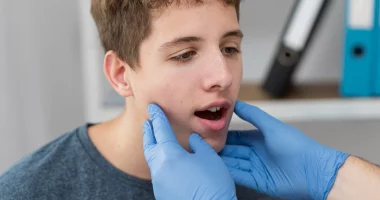Breast cancer is a type of cancer that spreads into surrounding tissues. It usually starts because of changes in genes or damage to DNA. Treatments can include radiation, surgery, or drugs (chemotherapy).
While breast cancer can affect both women and men, this article focuses on how it affects women. Often, breast cancer doesn’t show symptoms, but some signs can include a mass in the breast, modifications in the nipple, or pain in the breast or armpit.
If someone notices any signs of breast cancer, it’s important to talk to a doctor right away. Getting diagnosed and treated quickly can improve the chances of getting better.
Symptoms
According to the American Cancer Society, the most common symptom of breast cancer is finding a lump or mass in the breast or underarm area. This lump might feel different from the surrounding breast tissue and can vary in size.
Other symptoms that could indicate breast cancer include changes in the texture of the breast skin, such as dimpling or pitting that resembles the skin of an orange. Additionally, nipple discharge, swelling of the breast, nipple or breast pain, and a sunken or inverted nipple are also potential signs.
Less commonly, breast cancer may cause dryness, flaking, or thickening of the breast or nipple skin, and sometimes swollen lymph nodes in the armpit or around the collarbone area.
It’s important to note that most breast lumps are not cancerous, but it’s crucial for anyone who notices a breast lump or experiences any of these symptoms to consult a healthcare professional promptly for evaluation and appropriate management. Early detection and treatment can greatly improve the chances of successful outcomes.
Causes
Breast cancer grows due to genetic mutuations that can be acquired or inherited through factors like exposure to estrogen or inherited genetic irregularities. Certain gene mutations, such as BRCA1 and BRCA2, are linked to a higher risk of breast cancer.
Normally, the immune system identifies and attacks abnormal DNA or developments, but it fails to do so effectively in cancerous conditions. This allows cells within the breast tissue to multiply uncontrollably, disrupting the normal cell cycle where cells grow, divide, and die in a regulated manner.
The unchecked growth of these abnormal cells leads to the formation of a tumor, which can grow and spread, depriving surrounding healthy cells of essential nutrients and energy. Early detection and intervention are crucial to managing breast cancer effectively and improving patient outcomes.
Types of Breast Cancer
Female breasts, developing after puberty, primarily consist of connective tissue, fat, and lobes containing milk-producing glands known as lobules. Breast cancer commonly manifests as lobular carcinoma, originating in these lobules, or ductal carcinoma, beginning in the milk ducts that transport milk to the nipples.
Invasive vs. Noninvasive Breast Cancer
Invasive breast cancer signifies cancerous cells spreading beyond their original location into nearby tissues. From there, cancer can potentially metastasize to other parts of the body, making treatment and management more challenging.
While comparising, noninvasive breast cancer remains confined to its initial site of origin. Often termed a “precancerous lesion,” these cells have the potential to become invasive over time if not appropriately managed. Early detection and timely intervention are critical in both types to improve outcomes and ensure effective treatment.
Breast Cancer Risk Factors
Several factors can increase the likelihood of developing breast cancer.
- Age: The chance of breast cancer rises with age. Most new cases occur in women over 40, with significant increases seen in older age groups, according to recent research.
- Genetics: Inheriting mutations in genes like BRCA1, BRCA2, and TP53 can significantly increase the risk of breast cancer, as well as ovarian cancer in some cases. Family history of breast cancer also plays a role in determining individual risk.
- Testing Guidelines: Present guidelines recommend genetic testing for individuals with a family history of breast, ovarian, or related cancers, especially among those of Ashkenazi Jewish descent, where BRCA mutations are more prevalent.
- History of Breast Conditions: Previous breast cancer or certain noncancerous conditions like atypical ductal hyperplasia can elevate the risk of increasing breast cancer.
- Hormone Exposure: Prolonged exposure to progesterone and estrogen, whether through early puberty, late menopause, or hormone replacement therapy, may increase breast cancer risk. Some studies suggest a link between oral contraceptives and a slight increase in risk.
- Race and Ethnicity: While breast cancer incidence rates are highest among non-Hispanic white women, mortality rates are higher among Black women. This disparity is influenced by factors like socioeconomic status and access to healthcare.
- Impact of Late Diagnosis: Difficulty accessing quality healthcare, particularly among marginalized groups, contributes to later diagnoses and poorer outcomes in breast cancer treatment.
Diagnosing Breast Cancer
Breast cancer diagnosis typically occurs either through routine screening or when symptoms prompt a medical visit. Various tests and procedures aid in confirming a diagnosis:
Breast Exams
These includes palpating the breasts to detect any lumps or suspicious changes. The examination may require different arm positions to thoroughly assess the breast tissue.
Imaging Tests
Several imaging techniques help in detecting and evaluating breast cancer:
- Mammogram: This X-ray imaging is a standard screening tool that reveals abnormal growths or calcifications in the breast tissue.
- Ultrasound: Used to assess the texture and size of a lump, distinguishing between solid masses and fluid-filled cysts.
- MRI: Combines multiple images to provide a detailed view of breast tissue, often used to follow up on suspicious findings from ultrasounds or mammograms.
Biopsy
A crucial procedure where a tissue sample is taken and examined under a microscope. This analysis determines whether cells are cancerous, identifies the type of cancer, and assesses hormone receptor status.
Based on these diagnostic findings, doctors stage the cancer by determining tumor size and spread. Staging informs prognosis and guides treatment decisions, ensuring individuals receive the most effective care tailored to their specific condition and needs. Early diagnosis through these methods is crucial for improving outcomes in breast cancer management.
Treating Breast Cancer
The approach to treating breast cancer varies depending on factors such as the stage and type of cancer, hormone sensitivity of the tumor, and the individual’s age, health status, and preferences. Before deciding on a treatment plan, it’s essential for patients to discuss potential risks and benefits with their doctor.
Surgery
Surgical options depend on the cancer diagnosis and patient preferences:
- Lumpectomy: Removes the tumor and a small amount of surrounding healthy tissue, suitable for smaller tumors.
- Mastectomy: Removes the entire breast tissue, sometimes including lymph nodes if cancer has spread.
- Sentinel Node Biopsy and Axillary Lymph Node Dissection: Procedures to assess and potentially remove lymph nodes to determine cancer spread.
Radiation Therapy
Often used after lumpectomy or mastectomy, radiation therapy targets cancer cells with controlled radiation to eliminate residual cancer and decrease the risk of recurrence.
Chemotherapy
Administered either before surgery to shrink tumors (neoadjuvant chemotherapy) or after to eradicate remaining cancer cells (adjuvant chemotherapy), especially in cases with a high risk of recurrence or spread.
Hormone-Blocking Therapy
Effective for estrogen and progesterone receptor-positive cancers, hormone therapy can be given after surgery to prevent recurrence or before surgery to shrink tumors. It’s a viable option for those who may not undergo surgery, radiation, or chemotherapy.
Biological Treatment
Targeted therapies like trastuzumab also known as Herceptin and lapatinib Tykerb specifically target and destroy certain types of breast cancer cells, offering precise treatment options based on cancer subtype.
Each treatment option aims to effectively manage breast cancer while minimizing side effects, ensuring personalized care that aligns with the patient’s medical needs and preferences.
Summary
Breast cancer treatment options depend on factors such as cancer type, stage, and hormone sensitivity, alongside patient age, health, and preferences. Surgical choices range from lumpectomy for smaller tumors to mastectomy for more extensive removal, often followed by reconstructive surgery. Radiation therapy targets cancer cells post-surgery to reduce recurrence risk.
Chemotherapy, given before or after surgery, addresses high-risk cases by shrinking tumors or eliminating residual cancer cells. Hormone-blocking therapy, beneficial for hormone receptor-positive cancers, can prevent recurrence or shrink tumors. Targeted biological treatments like trastuzumab offer precise therapies for specific breast cancer types. Treatment decisions aim to optimize outcomes while considering individual medical circumstances and preferences.









